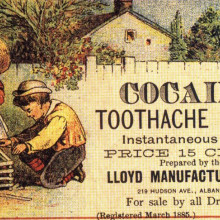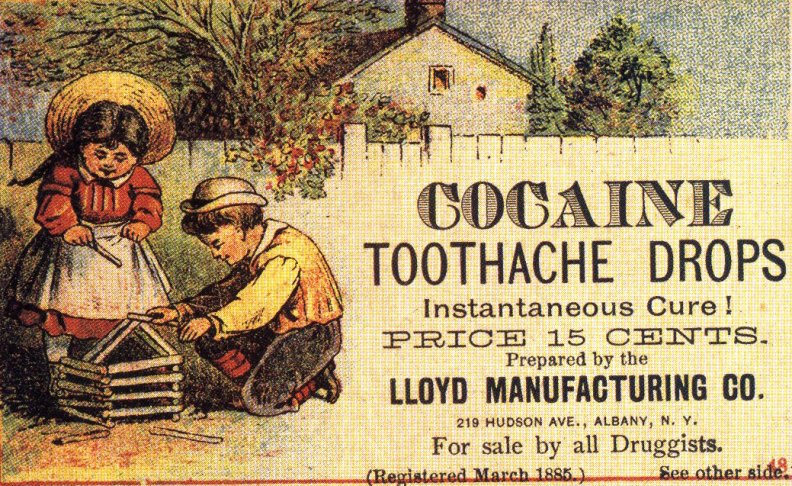Recovering from alcoholism via community creativity, goats high on psychedelics, cheeky monkeys on mojitos and can expectant mothers drink?
In this episode

00:00 - Can science combat stigma?
Can science combat stigma?
with Dr Karen Ersche, Cambridge University
Kicking off the programme, we've all seen headlines about addiction, whether it be to the internet, food, or drugs of abuse. There's a lot of research going on in this area and I visited Dr. Karen Ersche from the Department of Psychiatry, Cambridge University to find out why she studies addiction and how she thinks science can help destigmatise the issues.
Karen - I work in the field of drug addiction. I like to find out how drugs of  abuse turn people's lives upside down. People take cocaine, develop dependence and behave in a way that they lose their jobs, they make debts, they lose their relationships, families break up because of the drug, and it seems difficult to understand why are they still taking the drugs if the whole world around them falls apart. For many people and society, they think that these are just bad people or these are weak people because they just don't manage to get off the drug. As a scientist, to have an understanding of how the drugs work and how they change the brain in the longer term, and that is very helpful to improve treatment for people who have become addicted to drugs or how to prevent addiction in people who are at risk.
abuse turn people's lives upside down. People take cocaine, develop dependence and behave in a way that they lose their jobs, they make debts, they lose their relationships, families break up because of the drug, and it seems difficult to understand why are they still taking the drugs if the whole world around them falls apart. For many people and society, they think that these are just bad people or these are weak people because they just don't manage to get off the drug. As a scientist, to have an understanding of how the drugs work and how they change the brain in the longer term, and that is very helpful to improve treatment for people who have become addicted to drugs or how to prevent addiction in people who are at risk.
Hannah - And we'll be returning to Karen later in the show to find out about some of her research in the area.

How successful are addiction treatments?
Dr Amy Milton from Cambridge University gets to grips with this question......
Amy - It's very difficult to get relapse rates because when people relapse, they often then drop out of medical treatment. So, it's difficult to get follow up and you find that somewhere between 40% and 60% of individuals who've come for treatment are still abstinent, 1 year following the addiction or following treatment for the addiction. Of the remaining individuals, you have lapsed in that period then somewhere between 15% and 30% of those haven't become dependent again. So, they may have lapsed once but they've managed to regain control of their drug use to a degree.
Hannah - What type of treatments are these then? Are there some treatments that are more successful than others?
Amy - There are many different types of treatments and it's difficult to compare them, one against the other because what works for one individual won't necessarily work for another individual. As researchers, we talk about relapse in very, very general terms, but of course, ever individual who has become addicted has done so in a unique way and very unique set of reasons. The kinds of treatments that we're really thinking about here are what are sometimes known as substitution therapy. So, things like nicotine patches for smokers, methadone for heroin users. There's also cognitive and behavioural therapies, psychological therapies, other type of therapies, things like group therapies or family counselling, so the AA 12 Steps Programme, that sort of thing. And what works for one person may not work for someone else and what works for an individual may change at different points in their life as well.

Is drug addiction the same as gambling?
Dr Amy Milton from Cambridge University tackles this question.....
Amy - Well, that's a really timely question because the way in which psychiatric disorders are diagnosed is according to a reference to this book which is called The Diagnostic and Statistical Manual of Mental Disorders. Up until last month, we were using DSM4 in which gambling was not really considered an addiction. Pathological gambling was considered a mental disorder but wasn't considered along with addictions. The new version, which came out in May, now classifies gambling along with drugs of abuse in a single category of addiction. So, this is really quite a new field and there's some really good work being done actually here in Cambridge but also in the States as well, looking at the underlying neurobiological mechanisms of pathological gambling. The compulsive aspects of the disorders seem to be quite conserved, so that sort of compulsive nature of gambling is thought to rely on the same sort of circuitry as the compulsive nature of drug-seeking and drug-taking behaviour.

15:01 - Killing off pain
Killing off pain
Pain is one of the largest research areas in neuroscience today. It represents a large portion of the pharmaceutical industry's interest and poses a huge challenge to research scientists. Scientists are interested in exactly how pain works: how it is signalled and perceived by the brain, and significantly how we can intervene in this process to deliver relief to chronic pain patients.
One of the most widely used analgesics is morphine, which is a so-called opioid because it is derived from the opium poppy plant. Morphine acts on proteins in the nervous system called opioid receptors. Drugs like morphine bind to these opioid receptors and activate the body's natural pain-suppression system. The problem is that morphine has a large range of side-effects, things like tolerance, which occurs as your body adapts to the drug and you need more and more of the drug to achieve the same level of pain relief. Morphine is also highly addictive, which makes it a potentially dangerous drug, despite the fact that it is the gold-standard for pain relief.
Because of these dangerous side-effects scientists are determined to find new drugs that give the analgesic effects of morphine, but don't produce side-effects like tolerance and addiction. This has been the aim of a group of scientists from the University of Michigan Medical School, in collaboration with pharmaceutical companies, who have published exciting data a, in PNAS this week, about several new drugs they have identified.
These compounds act at the same opioid receptor that morphine does, but bind to a different place in the protein. This makes them more selective than other drugs and could result a reduction in the side-effects seen with other drugs. What makes these drugs particularly useful however, is that they aren't able to activate the receptors on their own, they require the presence of other molecules, like the natural endomorphins in the body or drugs like morphine before they will work.
These drugs could therefore be used in combination with lower doses of morphine or even as a natural enhancer of the body's pain relief system. This could help to reduce side effects and also could help to simply enhance natural pain relief. This study is obviously only the first stage in a long process of drug discovery, but the results are encouraging!

18:12 - Is alcohol safe during pregnancy?
Is alcohol safe during pregnancy?
Is a glass of wine a day too much during pregnancy? Moderate alcohol exposure during pregnancy is not linked to impairments in child's subsequent motor skills, new research has  shown.
shown.
Heavy drinking during pregnancy can harm unborn babies. Alcohol crosses the placenta and can stunt a baby's growth, cause distinctive facial changes and damage the developing brain, which can lead to poor memory, attention deficits, impulsive behavior and poor reasoning power. Dubbed fetal alcohol syndrome, up to 1 in 500 live births in the USA and Europe are affected.
To avoid this, practioners typically advise women to steer clear of alcohol whilst pregnant. But what about drinking smaller amounts? Say a glass of wine of an evening? Would this affect the child?
Over the last 10 years, researchers at Bristol University have followed almost 7000 children to find out, comparing their balance skills, which reflects brain development, with self-reported alcohol consumption logged by the childrens' mothers ten years previously while they were pregnant.
Three categories for alcohol exposure were used: no alcohol; low (1-2 glasses of wine per week) moderate (3-7 glasses) and high intake (over seven). The mothers' patterns of drinking were also recorded, either as binge drinking, or regular small quantities.
Children of women that drank moderately during pregnancy (3-7 small glasses of wine a week), performed slightly better at the balance tests than those whose mothers had abstained.
The same thing was seen when looking at paternal drinking consumption: moderate drinking fathers had slightly better-balanced children. Binge drinking, on the other hand, was associated with poorer balance control in their child.
But, moderately-imbibing mothers were from a higher social economic group and had greater levels of education, which may affect their children, including how they are raised, what types of activities or sports they do at home and the school they go to.
Also, it's important to note that these results do not imply that drinking one glass of wine each evening whilst pregnant will lead to a better balance in your children, years down the line. The research finds a link, but does not imply causation. Also, the researchers were looking only at balance at 10 years, and their may be other cognitive measures, which were no assessed, that were negatively impacted by modest drinking.
So, the safest advice probably remains to minimise alcohol intake in pregnancy...

22:17 - Is sibling rivalry a bad thing?
Is sibling rivalry a bad thing?
If you have a brother or sister you will probably be familiar with the arguments that typically occur in the average household when you were growing up. In fact, many people acknowledge these kinds of spats are a typical part of growing up: siblings always fight with each other right?
New research published in Pediatrics, this month suggests that effects of sibling aggression can be more significant than once thought. Lead author Corinna Jenkins Tucker and her colleagues at the University of New Hampshire have been looking at the relationship between sibling aggression and mental health
aggression can be more significant than once thought. Lead author Corinna Jenkins Tucker and her colleagues at the University of New Hampshire have been looking at the relationship between sibling aggression and mental health
Using information from the telephone interviews of over 3 and a half thousand children under the age of 17, Tucker and her colleagues looked at three types of sibling aggression: physical assault, either with or without a weapon or injury, property aggression, behaviours like stealing or breaking a siblings' possessions, and finally psychological aggression, behaviours like name-calling or saying mean things. They found that children who had experienced sibling aggression in the past year were more likely to be mentally distressed than those who did not experience sibling aggression. This effect was seen even if the children only experience one of the three types of sibling aggression, but this effect was greater in those experiencing 2 or 3 types of aggression.
Although these findings may not be particularly surprising, they are representative of the first large scale study looking at sibling aggression, which the authors suggest is under-represented in the scientific literature. People essentially assume that sibling aggression is much less important than peer aggression, when a child experiences bullying at schools from classmates for example, but the authors of this paper compared the effects of sibling aggression and peers aggression and found that the effects could be similar!
The conclusion is that we should be carefully looking for the effects of sibling aggression as these data suggest it is not as benign as people think.
Association of Sibling Aggression With Child and Adolescent Mental Health
Tucker et al. (2013) Pediatrics, 2012-3801; published ahead of print, June 17, 2013,doi:10.1542/peds.2012-3801

25:22 - How are food and cocaine linked?
How are food and cocaine linked?
with Dr Karen Ersche, Cambridge University
And closing this month's show, we return to Dr. Karen Ersche from the Department of Psychiatry in Cambridge to find out what's keeping her inspired with her research.
Karen - So, here in Cambridge, we are quite fortunate to have a strong community working on animal models of addiction. So, we know quite well how addiction develops, thanks to these animal models.
There is now another problem or epidemic developing and this is the epidemic of obesity. Well, there's an on-going discussion whether the model that works to explain addiction can also be applied to people who suffer from obesity or eats compulsively and the discussion is still on-going and also, the scientific evidence is debatable.
But what I find striking is that the people who are addicted to elicit drugs like  people addicted to cocaine, nobody has ever looked at what they are actually eating. So, although their model or their disorder is applied to another disorder, to obesity, very little is known how drug users really eat.
people addicted to cocaine, nobody has ever looked at what they are actually eating. So, although their model or their disorder is applied to another disorder, to obesity, very little is known how drug users really eat.
And so, I just, because I'm doing research in cocaine addiction, I thought I'll have a closer look of what my participants are eating and I noticed that there's a widely held misconception about what people with cocaine dependence eat because in the short term, cocaine has appetite suppressing effects. Some people don't eat when they're on the drug, but when the effects wear out, people do eat.
I noticed that they actually eat a lot of fat, but they are not overweight. So, this is quite surprising and remarkable and so, I had a closer look and I have done a study where I also measured body composition and had a closer look at people's diets. What it shows is that people with cocaine dependence, they don't put on weight and it seems that this might be an effect that cocaine exerts on their metabolism. So, it speeds up their metabolism that they don't put on weight. But when they stop, the do put on weight and they put on a lot of weight and they've also developed a habit of eating very fatty food which obviously makes you put on a lot of fat. That has an important impact on recovery because putting on weight when you are trying to get your life back in order is certainly not going to help.
Hannah - So, you found this after the blue result that links cocaine use with changing metabolism and almost like a craving for fat?
Karen - Well, I'm looking into this now and my research is to understand a person who has developed an addiction and to understand this person in the more holistic way by looking at their drug use and their compulsive use, and their addiction, but their addiction also has implications on what they eat, how healthy they are, on their immune system, on their sleeping patterns, on their well-being.
It may look that we are only looking at one little aspect of their life, but in fact, the deeper you dig into a problem, the more you understand the bigger picture. Also, hopefully, the easier it will be to help people to really live a more worthwhile life.










Comments
Add a comment